Magic has a rare distinction among games, in that for many players it has become a lifelong preoccupation. The incredible depth and variety of the card pool is what supports this long-term interest. But for newcomers, that variety can be intimidating. There’s such a range of formats and play styles to choose from, each of which appeals to different kinds of players.
How can a novice decide which deck to build or buy first if they don’t know what options are available? It’s a barrier that too many new players struggle to overcome. So today, I’ll try to break down your options the way Magic does: color by color.
Before I do, though, I want to quickly preface it with an essential Magic truism: There are no absolute statements in this game. With such a massive card pool built up over 26 years, exceptions exist to any general rule or advice. So whenever you hear something like “red is the aggro color” or “life gain is bad,” you’ll always be able to find and lean into the exceptions if you’re determined to. Suggestions like these are intended to help guide new players, not to limit your creativity or imagination. That being said, some decks are cheaper, easier to play, or simply more effective than others — so often, this advice is based on what’s good for players making their start in Magic.
WHY COLOR MATTERS
The fundamental game design of Magic is guided by the color pie. This imagined pie chart divides all the available effects a Magic card can have into five schools, each united by an ideological theme and represented by a color and basic land type. Because all the cards in a color can be cast using that same type of land, they are vastly more likely to appear in the same decks, leading to consistent, recognizable play styles across decks which play that color.
The color pie creates diversity and makes the puzzle of deck-building far more interesting; it’s hard to make a deck that can do everything. For most types of spell — “kill a creature,” “draw two cards,” and so forth — there will be more than one color that can produce that effect, but one will be better at it than another. A third color might be able to approximate the effect or achieve a similar result through different means. Usually, the other two colors will be unable to access that effect at all! This means each deck will have certain predictable holes in its strategy, and many players will consider building multi-colored decks to cover these weaknesses.
However, because most lands only make one, perhaps two colors of mana, adding different colored spells to your deck increases your risk of drawing the wrong mix of lands to play them, leaving you powerless. To avoid this frustration, it is usually recommended for new players to start with “mono-color” decks. These single-colored decks are simpler and more focused strategically, giving you a clear impression of what that color does. They’re also more affordable: good multi-colored lands are always in the top bracket of expensive cards because of their importance for tournament play, while mono-color decks work perfectly with only basic lands…which are essentially free!
While the colors of Magic are vast and the borders between them shift constantly, there are a few key aspects you can expect to find in each, both in flavor and in function.
WHITE
White is the color of civilization, fairness, law & order, protection & healing.
The aspect of fairness is central to white’s flavor. White has the fewest opportunities to draw extra cards, generate extra mana or play cards for free — those things sound a lot like cheating! White also lacks some of the ultra-powerful individual cards the other colors get. But it has the power to destroy and deal with any card in the game, including permanently exiling cards which would normally return to play. One of white’s most signature effects is the “wrath,” a spell that destroys every card on the battlefield at once — both yours and your opponents’. What could be more fair than that?

White’s affinity for law and order shows up in a few ways on its cards: bureaucratic effects that slow down and tax your opponent’s actions, and cards that effectively ban certain effects. White also has ways to punish those who break the rules, such as destroying a creature if it becomes too powerful.
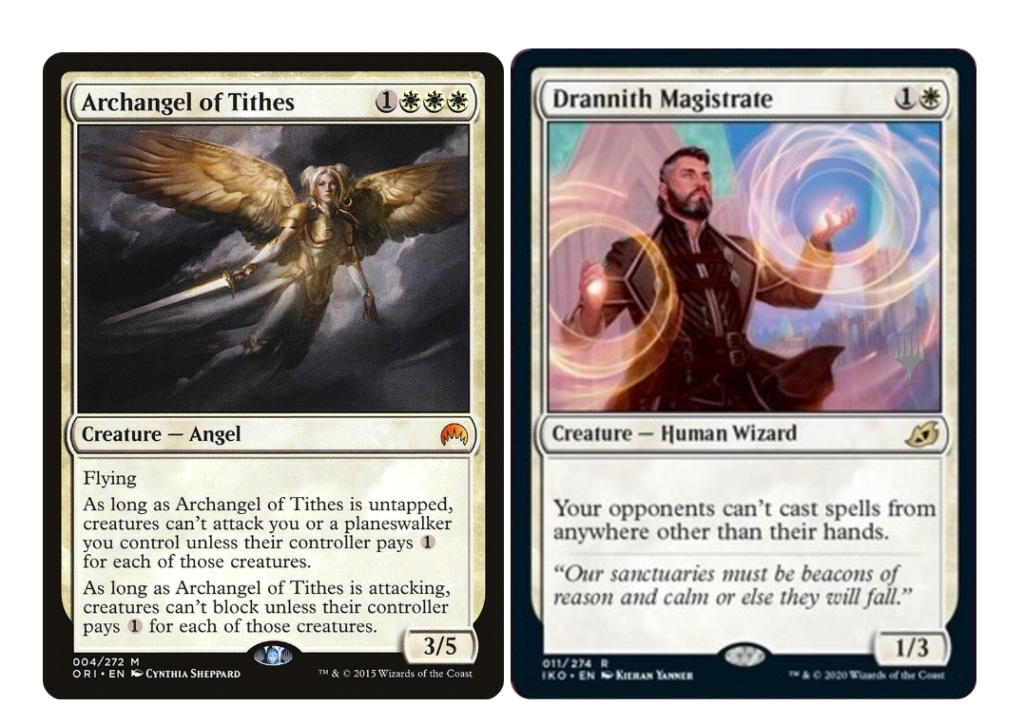
This sort of effect works because white has very few giant creatures of its own. Its aspect of civilization and organized society means white usually has many small creatures working together instead of larger ones. White’s aggression often involves buffing all its little creatures at once, with efficient effects known as “anthems.”
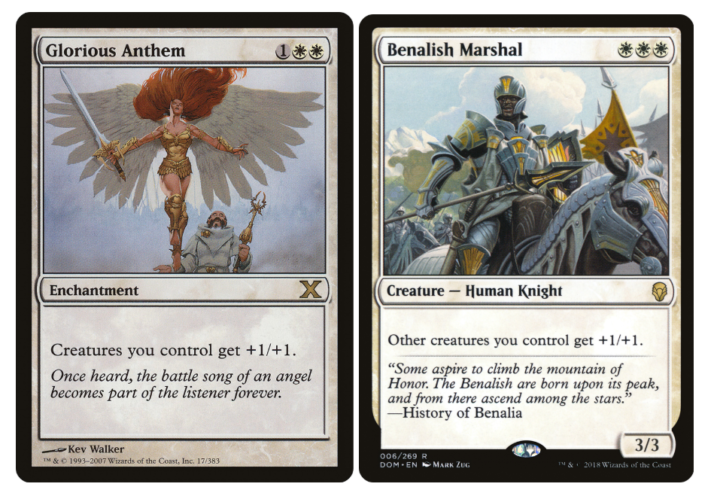
White’s civilized nature and patience also allow it to use artifacts and enchantments, especially equipment and aura cards that power up your small creatures.
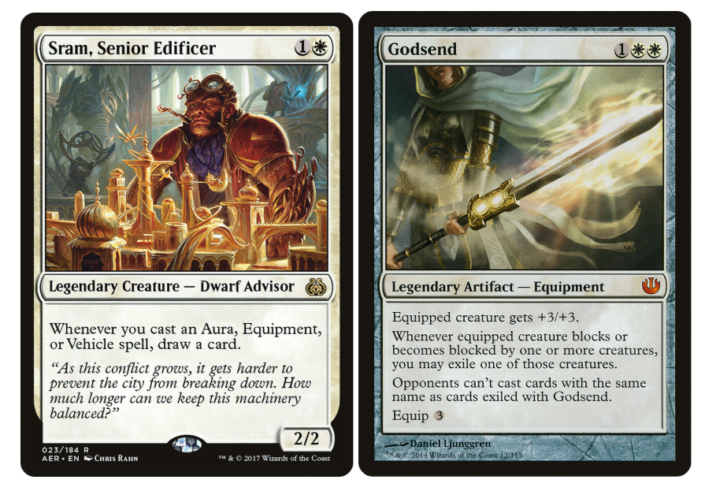
White’s protective and healing abilities are often maligned by experienced players. Effects that only gain you life without advancing your game plan can be less effective than one would hope; while you’re buying time, your opponent may be building a lead, and you’ll surely lose that life again if you fall behind them! But there are certain points in a game where life-gain can be pivotal, and using white’s defensive powers to protect your creatures instead can be game-winning.
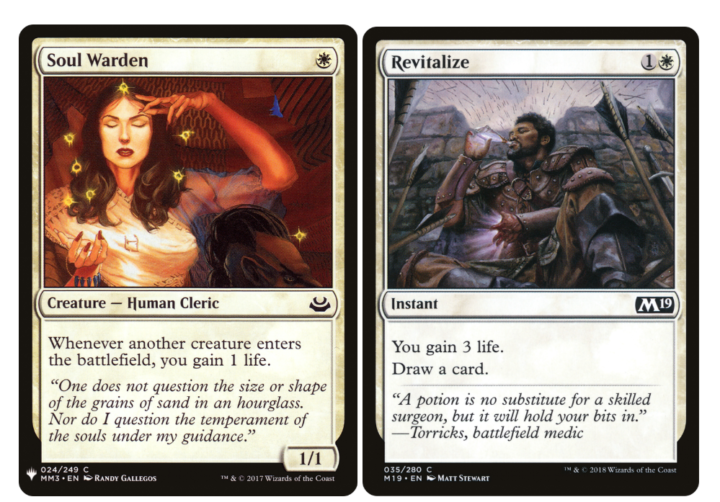
Finally, white also has some ability to revive cards from the graveyard to your hand or battlefield.
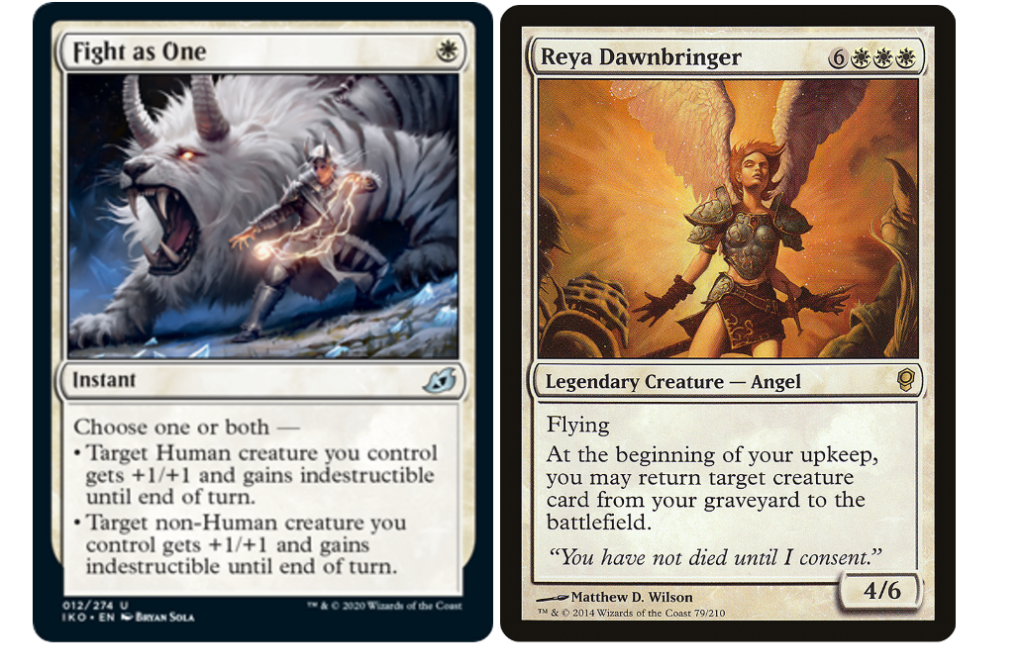
WHY PLAY WHITE?
Players who wield white magic prefer to fight on the battlefield, rather than in the hand. They can get by without having many instant-speed effects, or the ability to finely control which cards they draw. White prefers wars of attrition and winning by degrees. If you enjoy solving puzzles with the tools you’re given, and you enjoy the idea of always being able to kill your opponent’s best card or cancel out enemy combos, then white might be the color for you.
White’s most historically famous strategy is aggro. “White weenie” decks of yore dominated the first few turns of each game with the titular small creatures — then punished opponents with Wrath of God and Armageddon. The modern-day version of this deck leans on overwhelming numbers combined with an anthem buff for efficient damage, and a pinch of white’s all-purpose removal to clear a path.
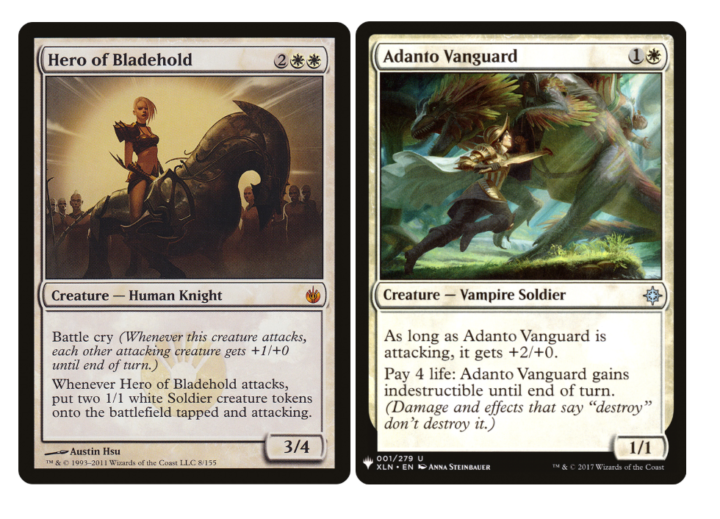
White’s best midrange deck is nicknamed “Death & Taxes.” Maximizing white’s taxing and law-keeping effects, these decks treat Magic like an arm-wrestle, tying up opposing resources and destroying the few cards opponents might play while little white creatures chip their life away.

White control decks almost always include blue cards, creating the most complete array of defensive abilities possible in Magic. Without blue’s card draw, white decks can lack the options and the sheer number of answers necessary to reliably keep control of these games. But by leaning on wraths, life-gain and layers of defensive enchantments, white can sometimes play a “pillowfort” style, becoming almost impossible to kill before enacting some slow but guaranteed victory.

White’s fair nature would seem to preclude it from playing combo strategies, but it does have several aspects which lend themselves to producing infinite value. “Flickering” creatures, a subset of white’s protective magic, or reanimating them from the graveyard can often create a loop, while white’s many defensive abilities can create “soft locks” that leave it invulnerable unless removed.

RED
Red is the color of chaos, speed, intense emotion (especially anger), the elements of earth and fire, and individual freedom.
Lightning Bolt was once voted the most iconic Magic card of all time, and its philosophy has defined the color red since 1993. Red’s advantage is speed — its cards are often designed for high immediate impact. This means a red player can fire off an entire hand of spells in just the first few turns of a game, overwhelming opponents before they get off the starting blocks.
Of course, like a fire running out of fuel, the red player will eventually start to stumble. But even after losing control of the board to larger enemy creatures, red can still finish the job with some Lightning Bolts aimed directly at an opponent! This basic formula for an aggressive red strategy is so well-defined, and works so consistently in any era of Magic, that veterans habitually name any new version “Red Deck Wins.”
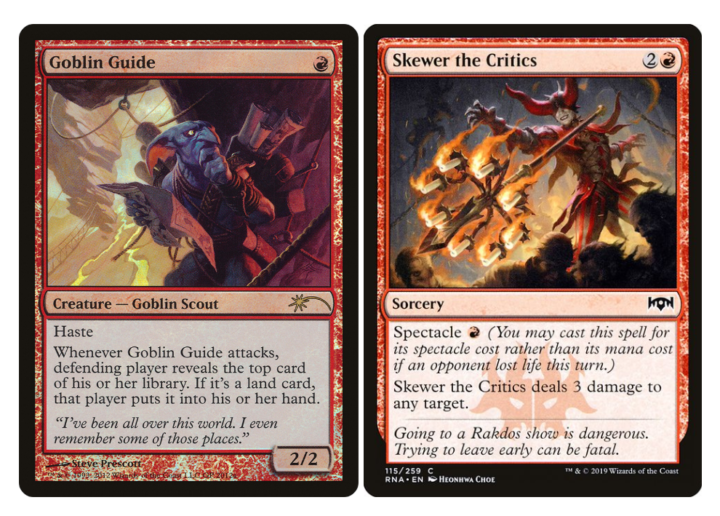
In many ways, competitive Magic is balanced around the yardstick of red aggro. But less aggressive red decks are certainly possible, and far from uncommon.
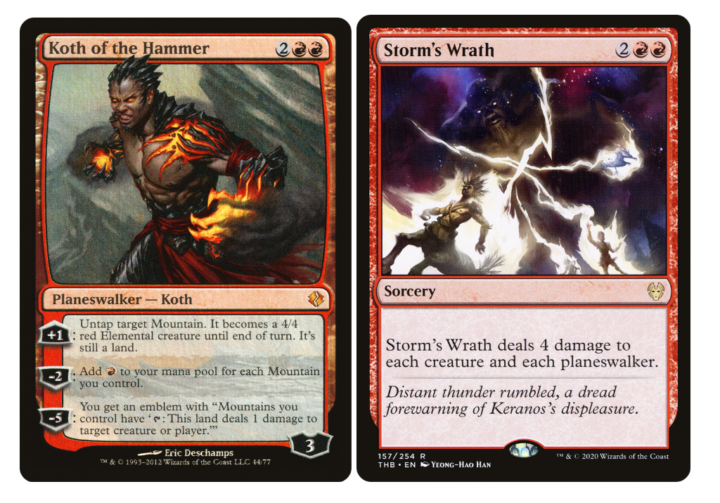
As seen on Lightning Bolt, red’s signature ability is to deal immediate, direct damage to any target. While not as powerful as the destructive spells of white and black, red’s damage has the flexibility to burn the opponent as well as their cards, making it hard to hold off forever.
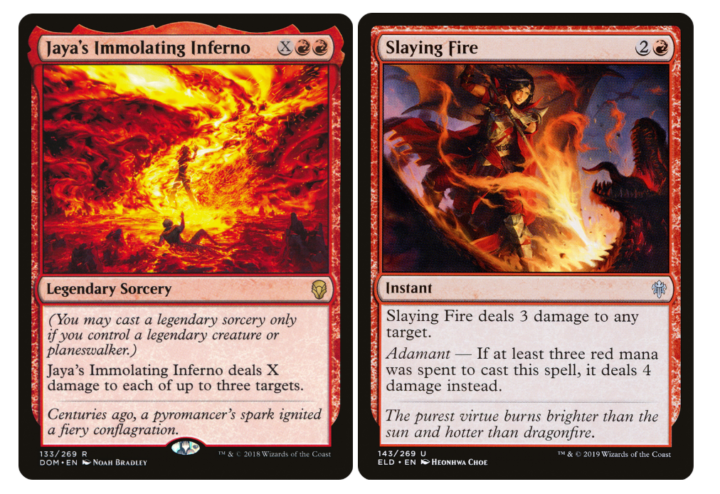
Red’s speed is represented on an individual card level by the haste ability, which allows creatures to attack and use tap abilities as soon as they enter play. Red has by far the most haste creatures out of any color, as well as many ways to grant haste to creatures which don’t normally have it.
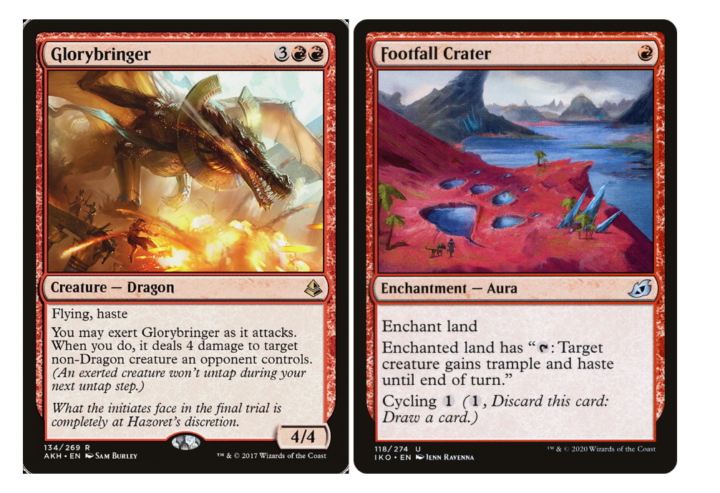
Red’s speed and impulsiveness are also shown through its use of “rituals”: cards that create a large temporary burst of mana so you can play an expensive, powerful spell very early in the game. They represent another way for red to sprint to victory.
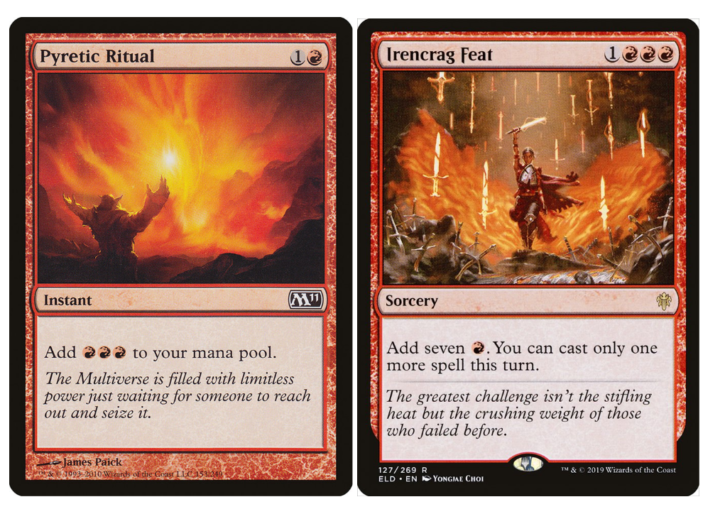
Red’s domain over impulsive and wild emotions gives it additional battlefield control. “Anger” spells force opposing creatures to attack or buff the power of your own attackers, while “cowardice” spells make creatures unable to block your assault. Another very common red effect is to steal control of enemy creatures for a turn, coercing them into an Act of Treason.

Red’s elemental capabilities embody geological forces and destruction. This can mean destroying enemy lands, burning enemy forces with fire and lightning, or simply summoning elementals and other fiery creatures like dragons and hellions.

Finally, red’s connection to the earth and metal gives it some affinity for artifacts, which tend to be created from such elements — as well as the ability to destroy them. However, it has very little interaction with enchantments.

WHY PLAY RED
Red players typically believe that a fast game is a good game! Even slower red decks tend to feature decisive plays within the first few turns. The typical red burn decks also pack a surprising density of complicated decisions for a color whose mascots are the slapstick, self-destructive goblins! No card will present more distinct opportunities for its use in a game than Lightning Bolt, and you’ll almost always have the chance to play all your cards before the game is decided — maximum decision-making!

Even the less aggressive red decks feature this accelerated decision-making, with red’s signature “looting” and “rummaging” card draw forcing decisions about which cards to keep in hand and which to discard.
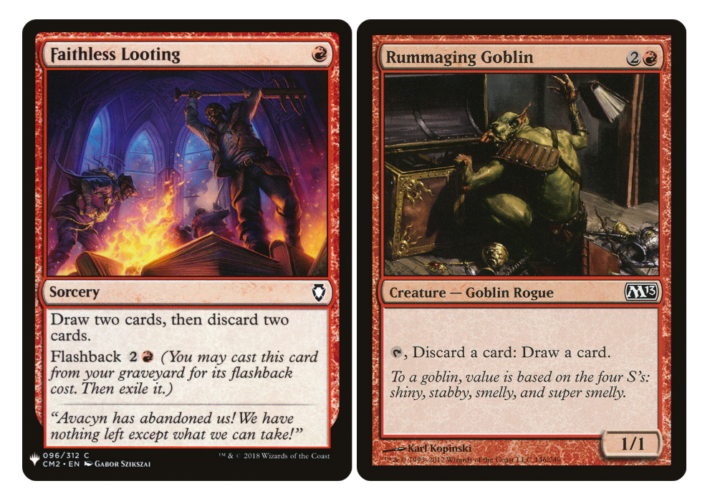
Red’s aggressive decks set the template for the other colors, attacking early and often with disposable but damaging creatures, then trying to end the game in a flash with direct damage spells. The constant threat of burn spells makes red a good choice for players who enjoy bluffing, but want to play something more proactive than blue.

Slower red decks tend to use their damage to control the battlefield instead of trying to win quickly. They often use Planeswalkers to generate card advantage and ongoing value once they establish control. In older formats, red “prison” decks blur the line between midrange and control, using rituals to play expensive and prohibitive effects early to tax an opponent before whittling their life away.
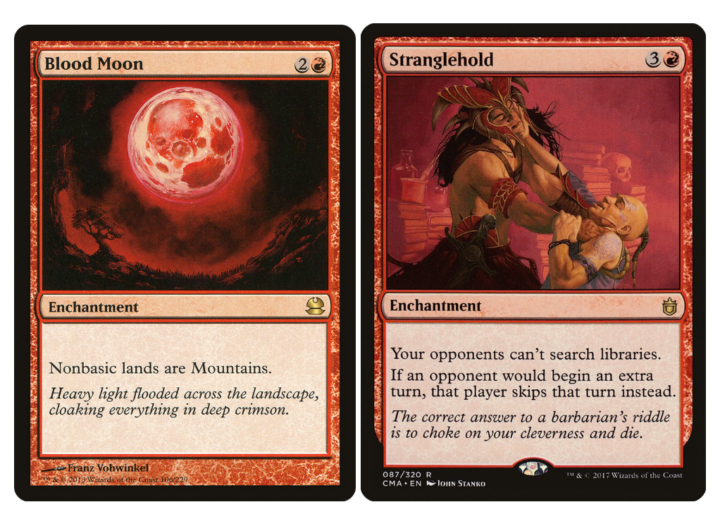
Red combo decks use red’s ability to quickly throw away cards and draw more to find the combo pieces they need, then use rituals to cast them all very quickly and win. Switching from “prison” pieces to combo pieces means you deny opponents the chance to come back, but the “prison” decks are more flexible in putting together a win and can ride a single turn-one spell to victory.
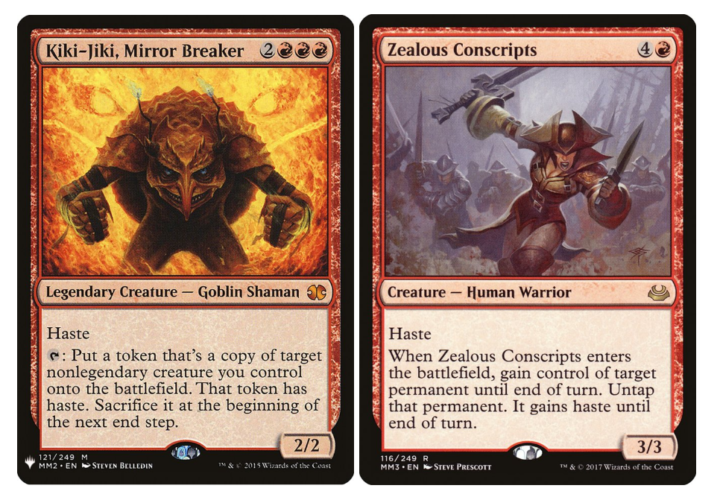
GREEN
Green is the color of raw strength, animals and plants, the natural order, regeneration, simplicity, fertility and growth.
Green has maybe the strongest intuitive identity of any color, besides black. It focuses on nature and emphasizes the ways of the animal kingdom — especially the idea that might makes right.
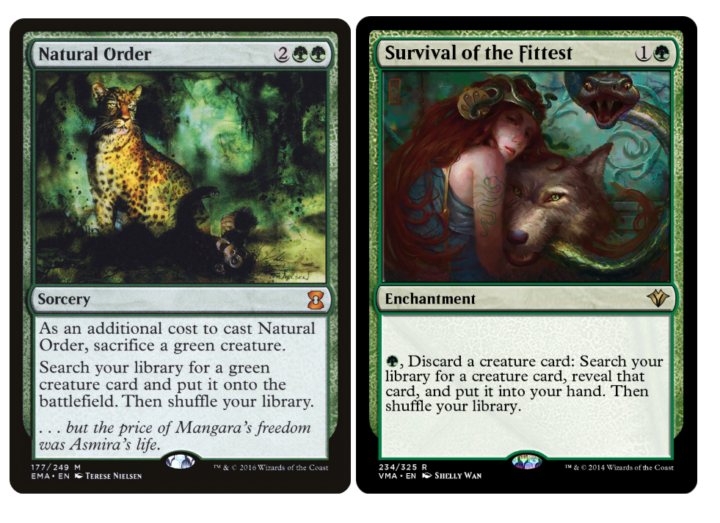
Green represents the power of the land and the beasts that live on it. Green gets bigger creatures and pays less for them than any other color, summoning wurms, dinosaurs and elephants with ease. This dominance gives it a simple game plan: green is the color that most consistently wins by just attacking in combat until the job is done. Green also has many ways to increase the strength of its creatures further when required, most famously with “combat tricks” like Giant Growth.

This straightforwardness does mean a green deck lacks options if it loses momentum. Where other colors can swing stalled games with an expensive angel, demon, dragon or sphinx flying over enemy defenses, green has almost no flying creatures at all. Instead, green doubles down on brute strength with the trample ability, which lets big creatures blast through the defenses of smaller blockers, and the “fight” mechanic, which forces weak enemy creatures to trade blows with yours even outside of normal combat.

Green’s other key aspect in gameplay is fertility and growth. This manifests as a rapid generation of resources, especially accelerated mana development. Green gets extra mana from “mana dorks” (creatures with the ability to tap for mana like lands do), by putting extra lands into play using spell effects (referred to as “ramp”), and by enchanting its lands to produce more mana than usual.

Unlike the rituals used by red and black, this mana advantage is permanent, and can snowball across several turns into a game-ending resource lead. “Ramp decks” such as this are perhaps the most famous archetypal green strategy.
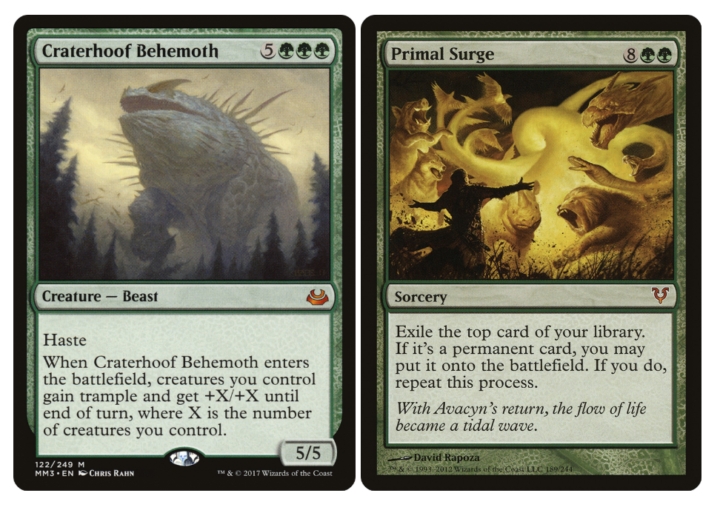
These ramp abilities also allow green decks to produce whatever color of mana they need on cue. Green is therefore a great backbone for multi-color decks.
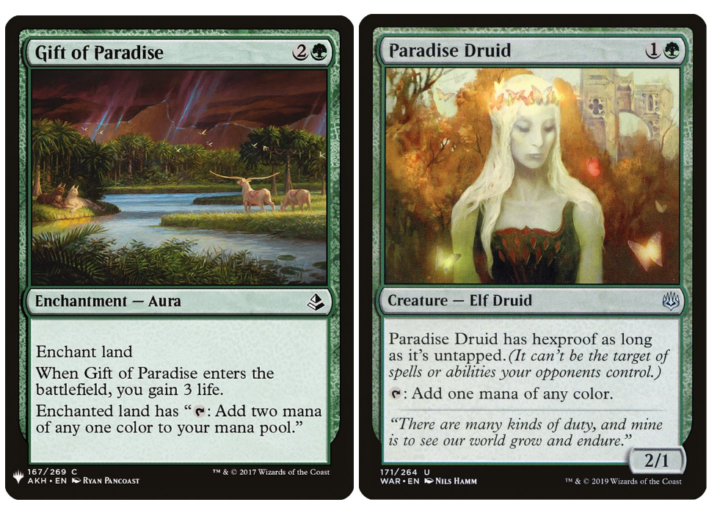
Green’s approach to healing is a natural one, more regenerative than preventive or curative. Its manifestations include the actual “regenerate” mechanic (found on older cards), as well as life-gain and the ability to “regrow” cards from the graveyard to hand.
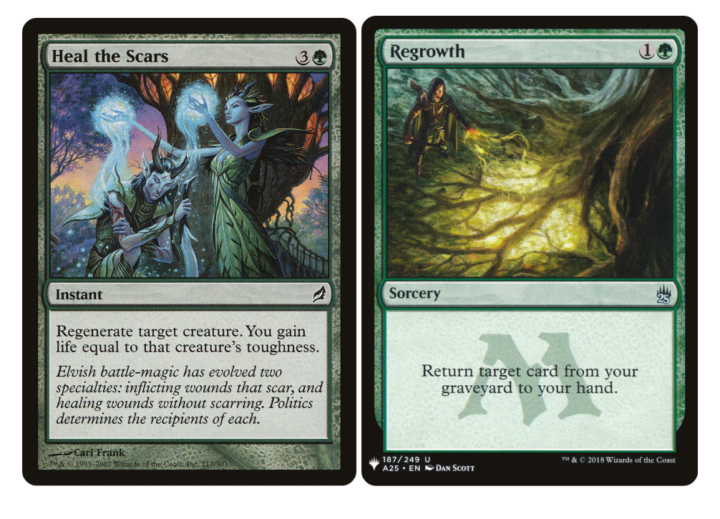
Green’s philosophical adherence to the natural order of things means it has little use for artifacts, and is very good at undoing and shrugging off enemy magic. Green can easily destroy artifacts and enchantments, and many of its creatures are untargetable by enemy spells thanks to hexproof. Others are immune to being countered by blue or discarded by black. These extra defenses help to make up for green’s own lack of interaction, its biggest weak spot compared to other colors.
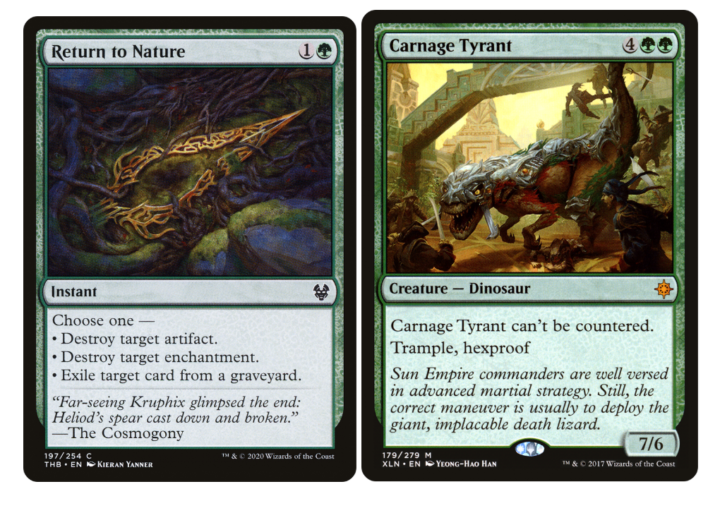
WHY PLAY GREEN?
Green players can appreciate the simple pleasure of playing powerful cards. If you want to feel like you’re throwing down the gauntlet, try casting some 5/4 creatures on turn two — or casting every card in your deck on turn five! Since it lacks interaction, skillful green play often comes down to sequencing your cards and knowing when to commit. And since green focuses so heavily on creature cards, it offers potential for combo and disruptive decks that always have a respectable plan B of smashing face! Most of all, green rewards players who want to be proactive, giving them the chance to accelerate toward the most powerful play.

Fast green decks and slow green decks differ based on how quickly they can cash in on the mana advantage the color generates. Aggressive green decks love to play a three-mana creature on turn two and immediately pressure opponents. Slower decks will spend a few more turns building up resources before casting a game-ending ten-mana spell on turn five.

Green combo decks tend to involve creature- or land-based combos, the two card types which green is best at searching its deck for and manipulating into play. Green’s philosophy makes it very ill-suited as a primary color in control decks, since it lacks good reactive plays and interaction in general.
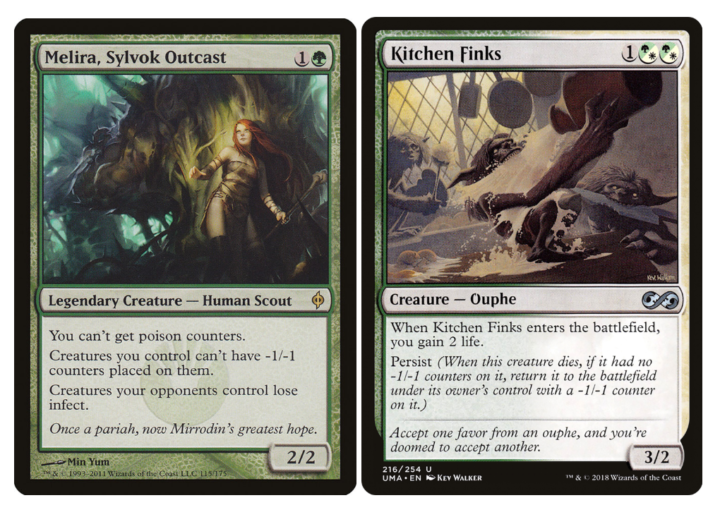
BLUE
Blue is the color of knowledge, willpower and control, artifice, trickery and illusion, and “magic” as a discipline practiced by wizards. It is also affiliated with the elemental forces of air and water, as well as time magic.
Blue is defined by knowledge and intellectualism, and it has the signature ability to draw and manipulate cards. This is among the most powerful things you can do in competitive Magic and has made blue historically the strongest color (which becomes more apparent in formats where cards from the 1990’s are legal). The association with learning is where we get the naming convention of “tutors,” referring to spells which can pull a card of your choice out of your deck on cue.
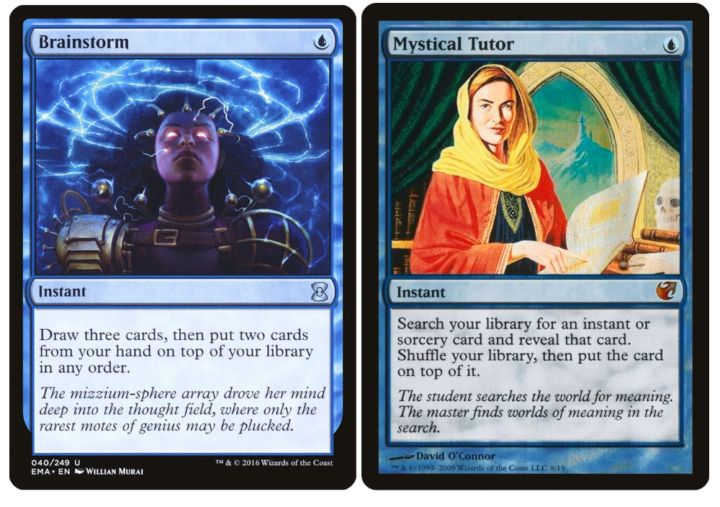
Blue’s superior willpower and desire for control is evident in its countermagic, which allows it to cancel any attempted action from an opponent. Countermagic can feel overpowering compared to the removal spells other colors play, as it stops any sort of card before it even enters the battlefield. However, the blue player must react the moment the spell is cast, saving the cards and mana to do so.
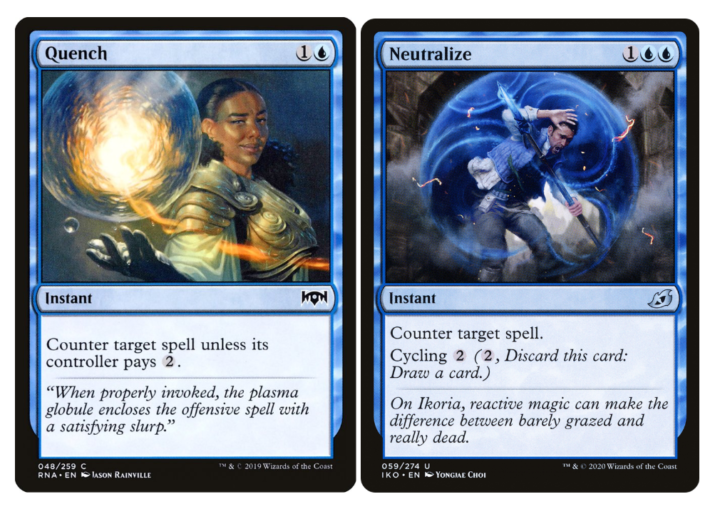
This style of deck, which plays mostly on the opponent’s turn and spends most of its cards reacting to and negating their spells, has become known as a “control deck.” While other colors have ways to replicate the control style, blue will forever be identified with it the way red is identified with aggro and green with ramp.
Blue’s famous weakness is that it cannot destroy enemy creatures completely. But it does have an arsenal of non-lethal ways to deal with such threats — and it can still counter them before they enter play. For instance, it can use controlling magic to permanently steal an opponent’s creatures or spells, though often at a high cost.
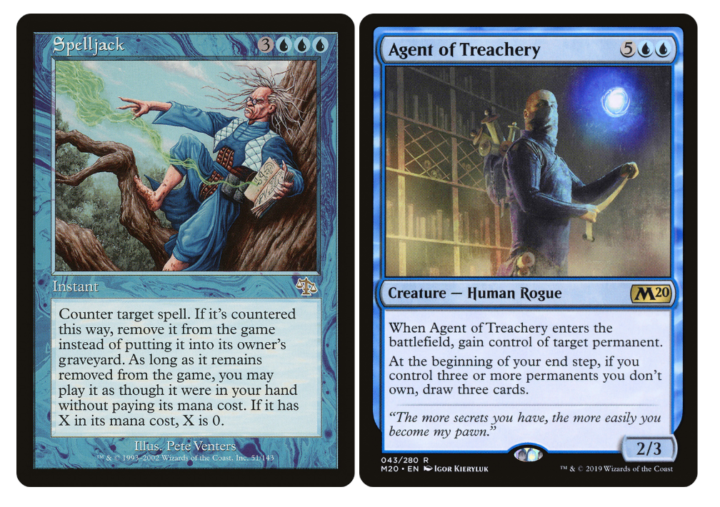
Blue’s trickery and illusion allow it to create copies of cards and spells, or cheaply disrupt enemy attackers by reducing their power.

It can use its time magic to return enemy cards to hand, forcing an opponent to pay for them again (and buying another chance to cast a counterspell when they do). Powerful blue spells allow it to take multiple turns in a row, and sometimes completely lock an opponent out to end the game.
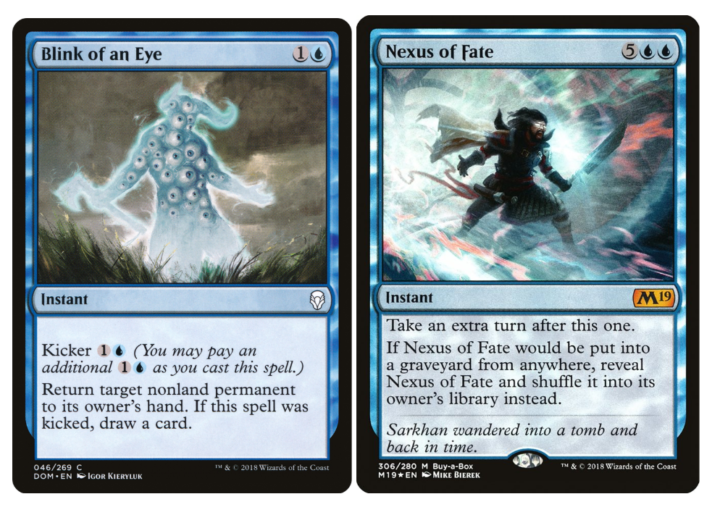
Blue’s combination of ice and sleep magic can achieve a similar effect on a budget. Freezing opposing cards in stasis prevents them from untapping, taking them out of the game for several turns.
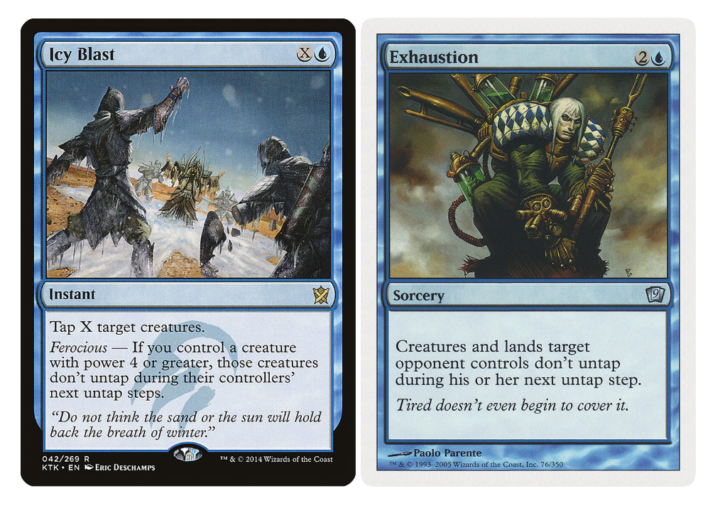
Finally, blue’s association with wizardry and spellcraft cause it to emphasize instants, sorceries and artifacts over creature cards, much more so than other colors. When blue does have creatures, they tend to have defensive or utilitarian purposes.
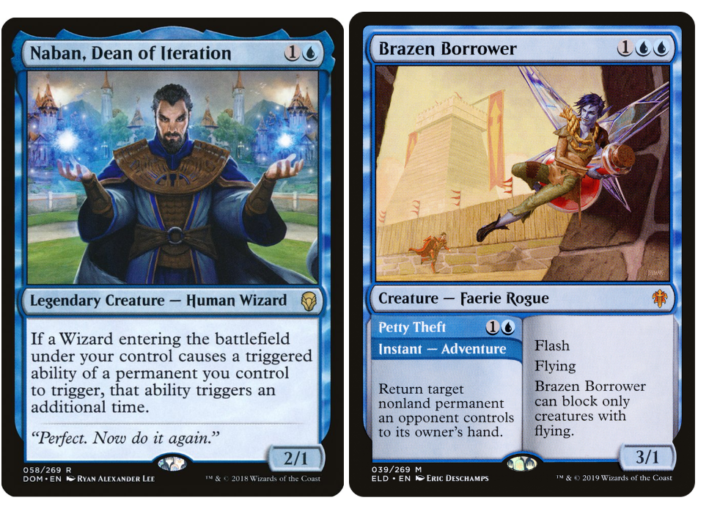
But even a control deck needs to win eventually. Therefore, most blue decks will contain one or two very expensive, very powerful creatures — genies, sphinxes or sea monsters — that can win the game once the opponent is under control.
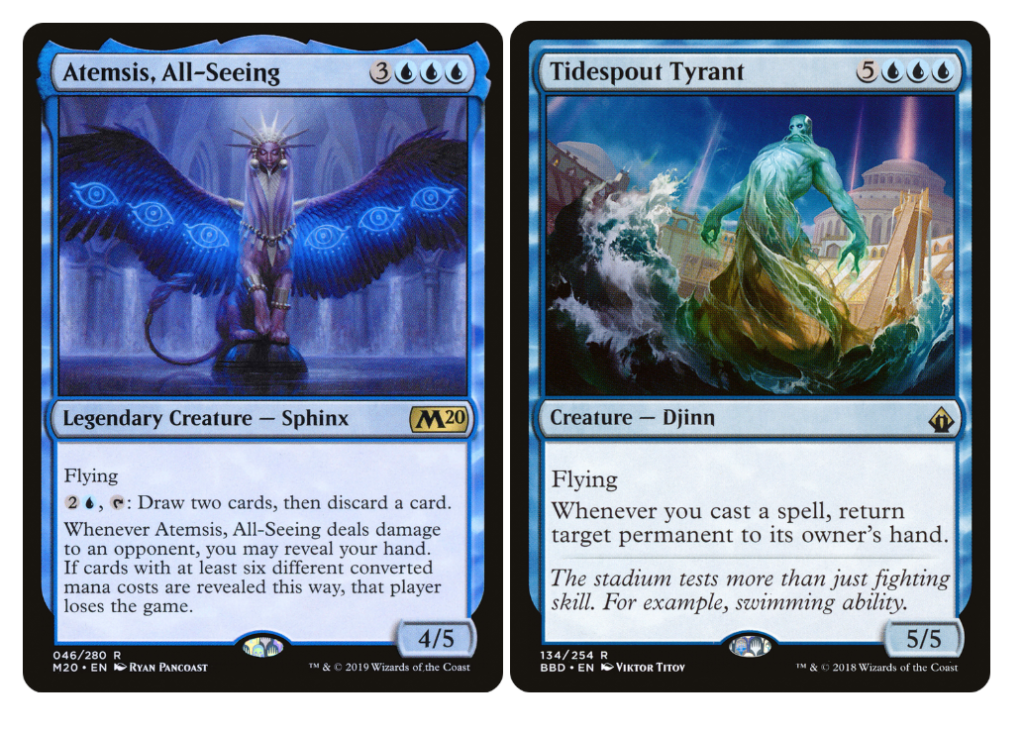
WHY PLAY BLUE?
Blue players prefer a cerebral, interactive style of Magic, and they prefer to play it at a significant advantage. Blue has the greatest ability to control which cards it draws, “seeing” more of the deck in an average game. In broad terms, this reduces how much luck-of-the-draw impacts blue’s chance of success, and gives players the greatest chance to decide their own fate. It’s not just a bit of jargon — if you feel like you enjoy being in control during a game, you should try playing blue.
Blue decks also demand an amount of patience and foresight, as well as research on other decks. If you’re using counterspells, you’ll need to plan when you will use them in each match.
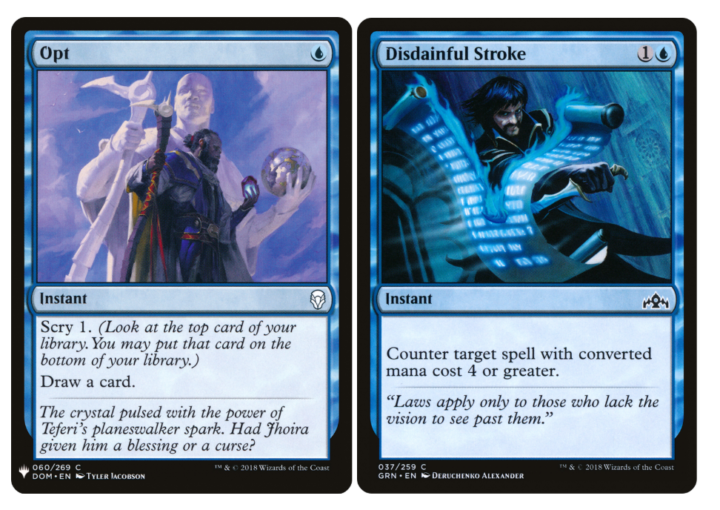
Aggressive blue decks do exist, and they bring a uniquely blue flavor to typical creature beatdown. Since many cheap blue creatures are hard to block thanks to flying or other abilities, so-called “tempo decks” aim to flip the usual control deck script. These decks get a small attacking force out quickly, and then use blue’s premier interaction to protect those creatures or slow down opposing ground forces. These decks work especially well in older formats, where threats such as Delver of Secrets anchor the strategy.
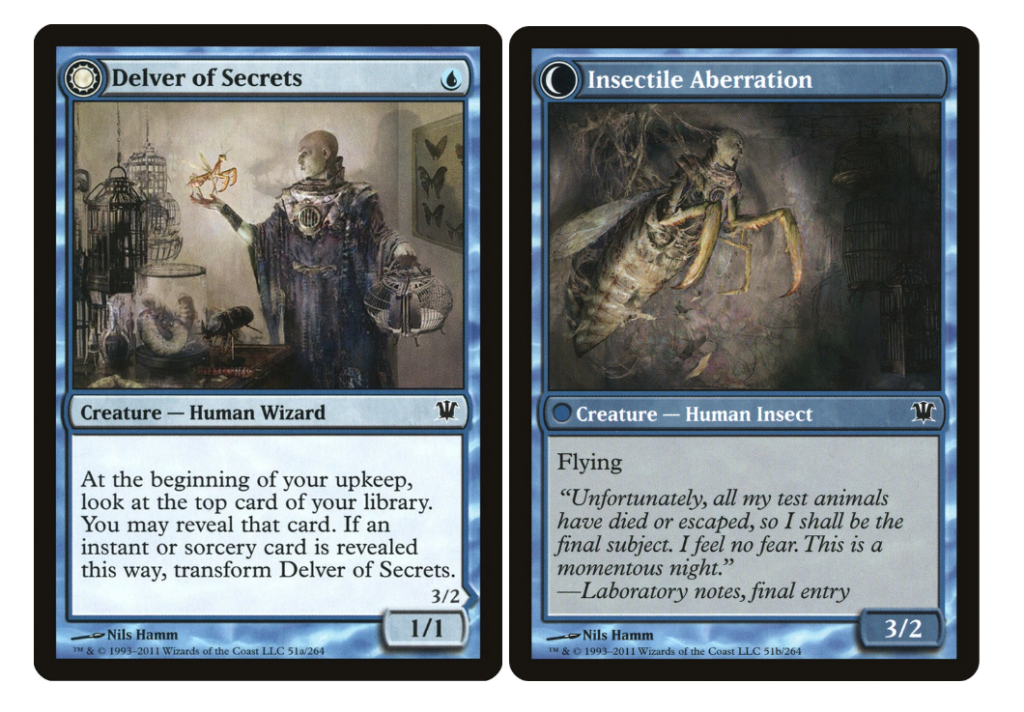
Midrange blue decks trade off threats to draw out opposing interaction without running out of gas. The versatility of counterspells gives blue players reassurance they won’t get blown out in the long game, and the ability to steal an opponent’s best card is the ultimate haymaker during back-and-forth midrange battles.
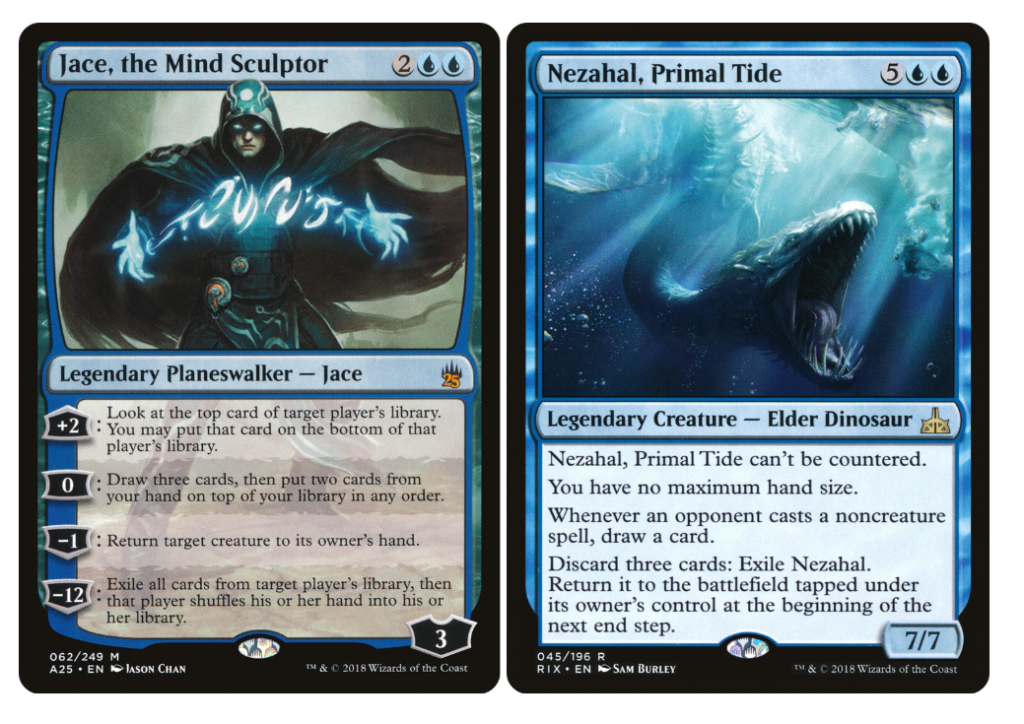
Blue control decks come in many shapes and sizes, having defined this play style since the dawn of Magic. While it’s always hard to prepare defenses against every possible angle of attack, the all-purpose counterspell and card-selection of blue draw spells gives you the best possible chance.
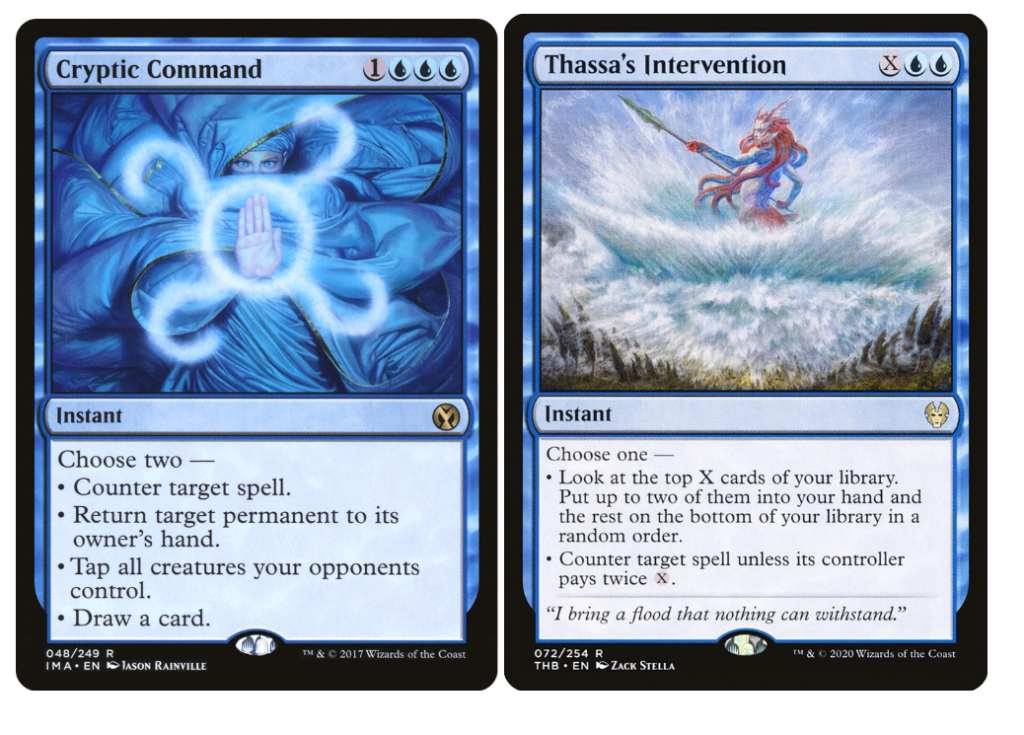
Blue combo decks can play at two speeds, and often revolve around artifacts. Blue can utilize all of its cheap, efficient card-selection spells (called “cantrips”) and tutors to assemble the perfect game-winning combo as fast as possible. Or, it can play combo-control; instead of stalling until you draw one giant creature, you can defend yourself until you can safely cast your hidden combo and win on the spot.
BLACK
Black is the color of ambition, sacrifice, forbidden knowledge, necromancy, suffering, fear, vampirism, and death.
One of the most famous black cards ever printed is Dark Confidant, a creature that draws you an extra card each turn, so long as you lose life equal to the cost of the card. Its flavor text sums the color up perfectly: “Greatness, at any cost.”
This ethos allows black to achieve almost any effect that the other colors can at nearly the same strength — but only by sacrificing life points, creatures, cards, and other resources.
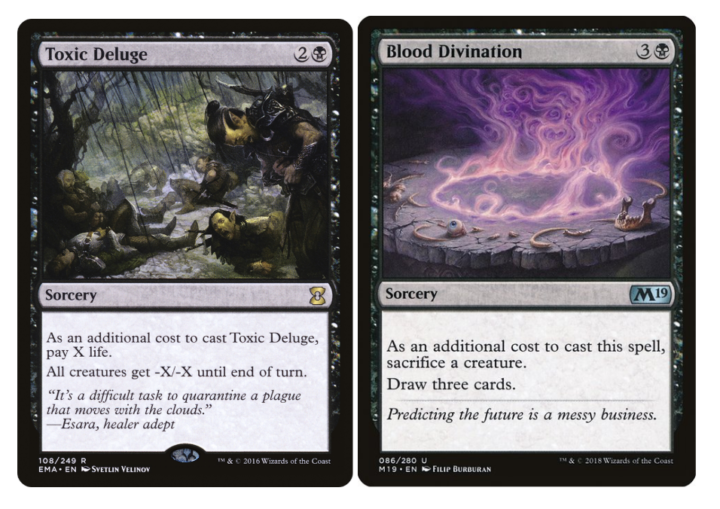
While some newer players instinctively shy away from these sacrifices, black cards are consistently among the most powerful in Magic’s long history. Necropotence, Reanimate, Dark Confidant, Yawgmoth’s Bargain, Thoughtseize and more teach novices in the dark arts a great lesson: the only life point that really matters is your last! Up ‘til that point, black decks are able to draw cards, destroy creatures, and harass their enemies without worrying about a thing. This imbalance causes many black effects to feel distinctly unfair — a stark contrast to its enemy color, white.

The most straightforward expression of black’s grand ambition is through its “big mana” strategies. While the end goal is similar to green’s ramp decks — generate a huge amount of resources to play something game-winning — black isn’t interested in steadily building up resources. Black wants to get rich quick or die trying, generating the mana with one-off rituals, transmuting it from life points or sacrificed creatures, and using powerful cards that can generate a wealth of mana on their own.
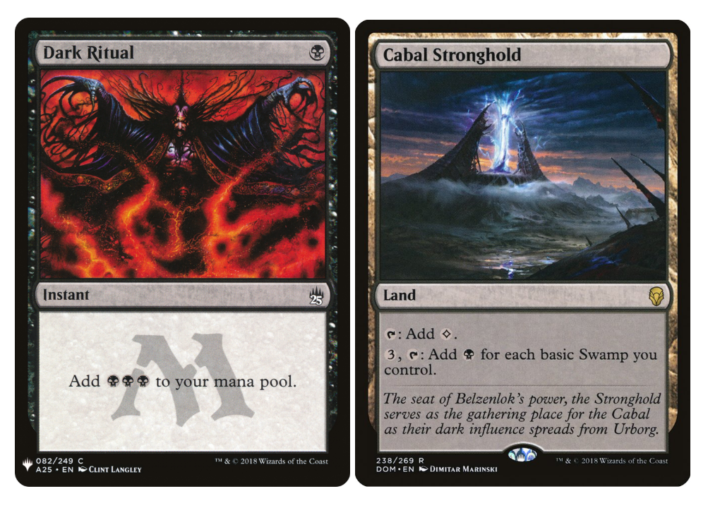
Many of black’s biggest plays come from harnessing the supposed costs or drawbacks of its cards. Discarding a card to Rankle, Master of Pranks only matters if you have any left in hand to begin with. Sacrificing a creature sounds intimidating until you realize just how good black is at generating token creatures as fodder. In either case, you can also intentionally discard or sacrifice an expensive and powerful creature… only to return it to the battlefield from your graveyard! Black’s “reanimation” effects are the best around, and they present the fastest route to controlling a giant monster in all of Magic.
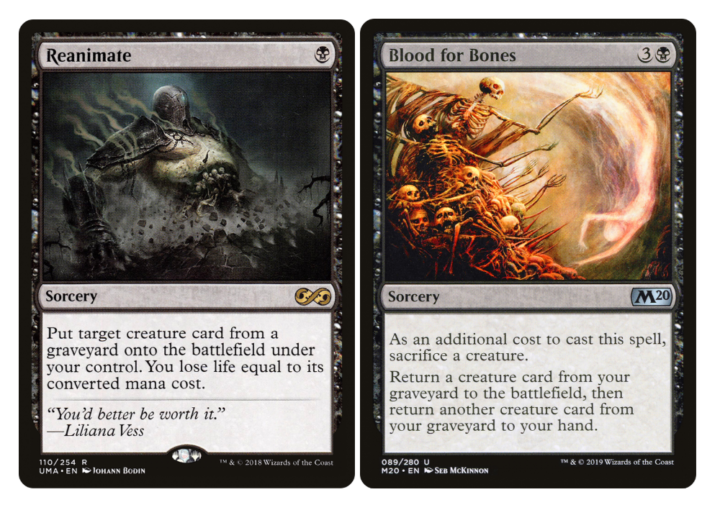
Even when you’re not playing creatures out of the graveyard, black mages love to keep that zone fully stocked with cards. Plenty of playable black spells also happen to throw a few cards from your deck into the graveyard as a bonus, and mechanics like delve, dredge, escape, undergrowth and unearth all reward you for it. Every color has its unique ways to play around the graveyard, but black is the undisputed master.

Black manifests its theme of forbidden knowledge with a suite of draw spells second only to blue’s. But when it comes to tutor effects, black’s shameless, goal-oriented nature lets it go a step further than other colors. Typically, tutor spells allow each color to search only for a card of a particular type associated with them. Worldly Tutor finds green a creature, and Enlightened Tutor finds white an artifact or enchantment. Only black’s Vampiric Tutor is capable of finding whichever card you most desire, with no restrictions other than the drop of blood you offer up to cast it!
Black has a strong connection with vampiric magic in general. Vampirism allows it to offset the life point costs of its other spells by draining the life from opponents and their creatures. It also frequently summons actual vampires in its armies, a second iconic creature type to complement its endless hordes of zombies.

Black’s mastery of death magic makes it the most powerful color for destroying creatures and Planeswalkers — though its ability to remove enemy artifacts and enchantments is almost nil. There are so many ways for black to kill a creature that no matter what defensive powers a target might possess, black will find a way around them.
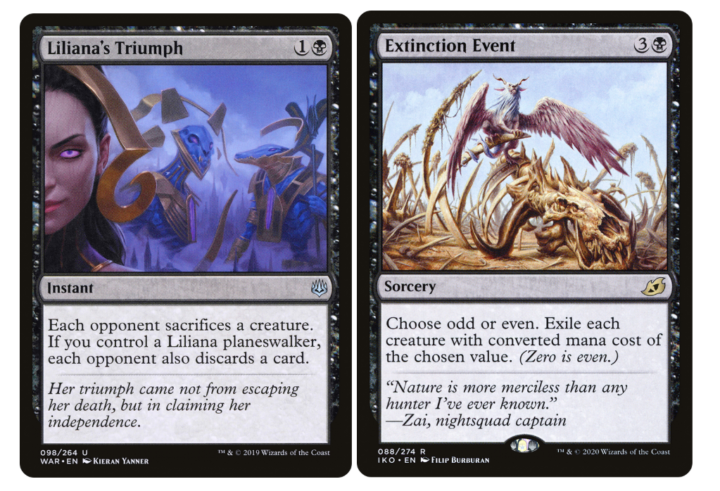
It also shares white’s ability to wipe out every creature in play — and on rare occasions, black gets a version that only decimates your opponents.
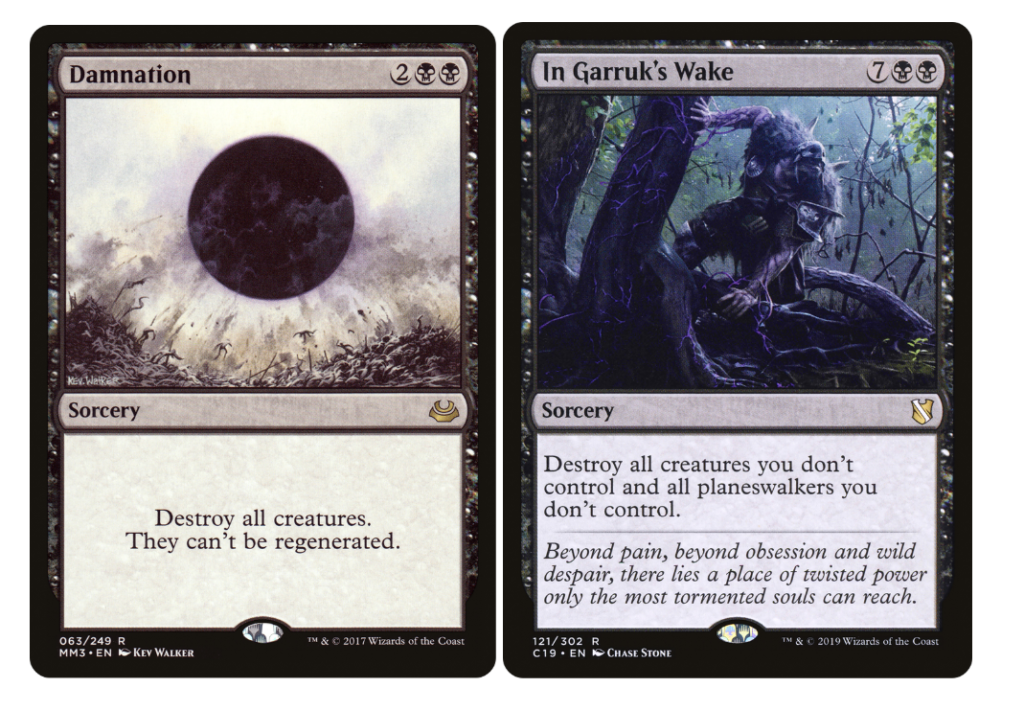
Even more interesting is black’s ability to profit directly off the death and suffering of creatures, including its own. Cards such as Blood Artist and Harvester of Souls provide another way to break the symmetry of wraths. While black sometimes leans on token creatures to fuel these sacrifice strategies, it also has access to many cheap creatures that reanimate themselves for a small cost.
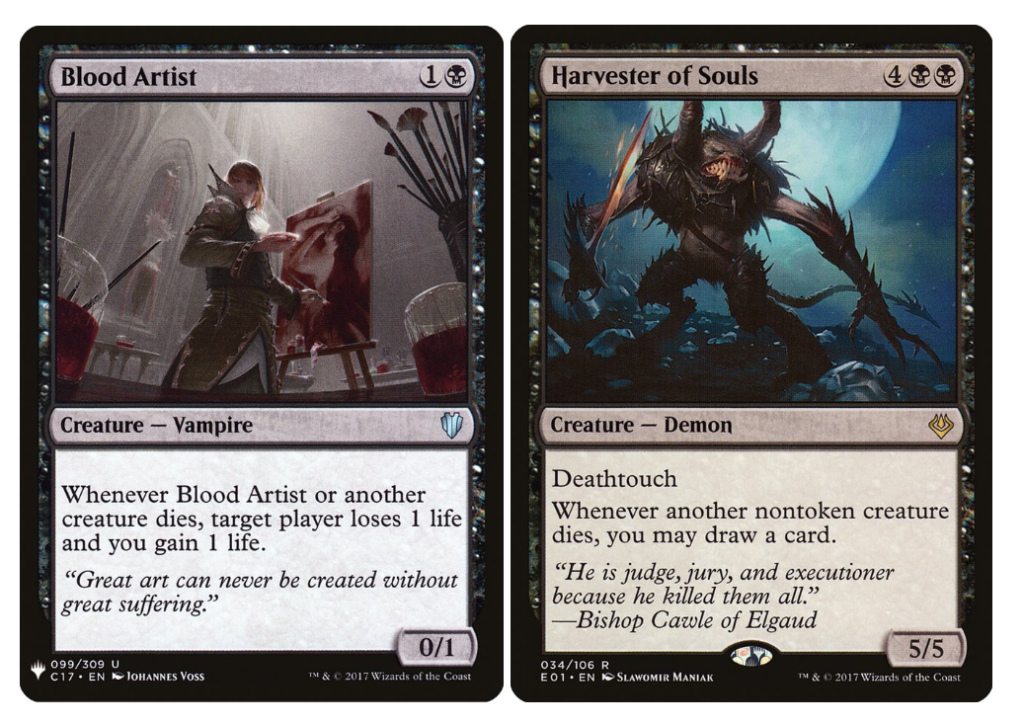
This inexhaustible supply of cannon fodder allows black to eke out incremental advantages and dominate combat just as effectively as green’s enormous monsters. Underestimate the humble Reassembling Skeleton at your peril!

Black’s control over fear and dementia lead to another vital power: hand disruption. Black can use discard spells to remove an opponent’s best cards before they ever have the chance to play them. In some cases, black can go further still, purging all copies of an essential card from an opponent’s deck!
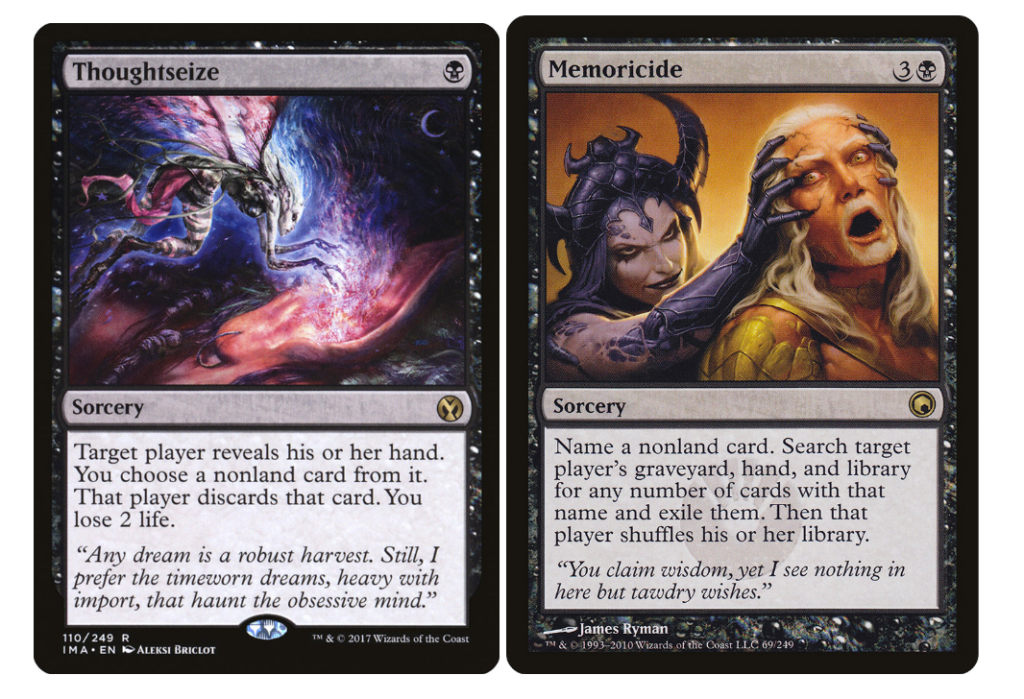
WHY PLAY BLACK?
Black appeals to players who like to feel like they’re “getting away with something.” Black allows for a lot of flexible resource management, being able to reanimate and sacrifice creatures at advantageous rates while generating bursts of mana, life, and card draw. Black’s focus on recurring and replaying cards can appeal to players who fear having their toys taken from them. And if you want to force opponents to play the game on your terms, nothing is more potent than black’s heavy-duty resource denial. For players who don’t mind casting themselves as the villain (or even relish it!), black is an excellent choice.
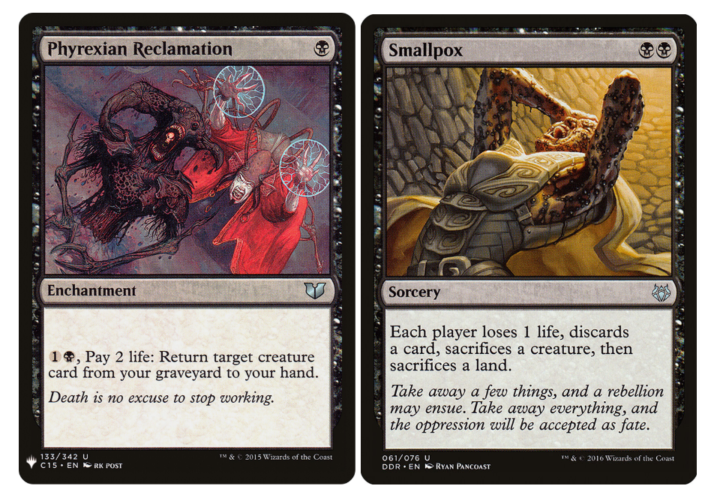
Aggressive black decks make heavy use of discard spells to shred an opponent’s opening hand, and then overwhelm them before they can recover. Any defending creatures can be brushed aside with black’s excellent destructive spells. Even when the enemy is able to kill off black’s own creatures, many cause additional damage when they die or can return to life to keep up the pressure.
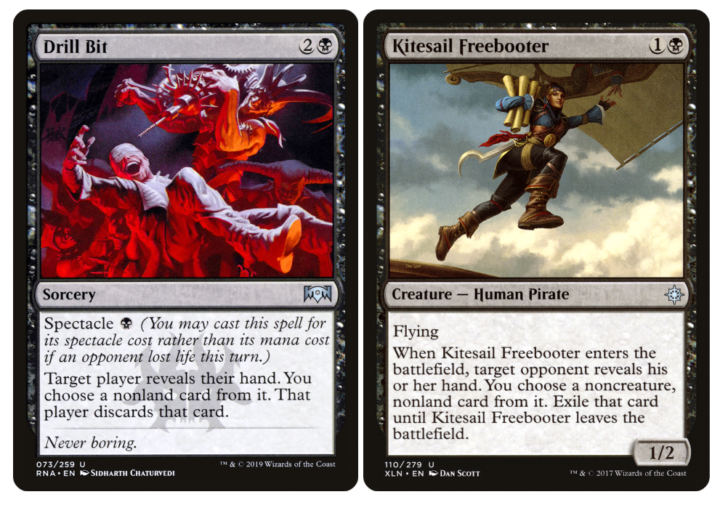
Black midrange decks turn games into a war of attrition, using hand disruption and resource denial to paralyze opponents while destroying any cards in play. In these long games, black’s graveyard recursion keeps it from running out of cards while poison or disease effects gradually chew away an opponent’s life.
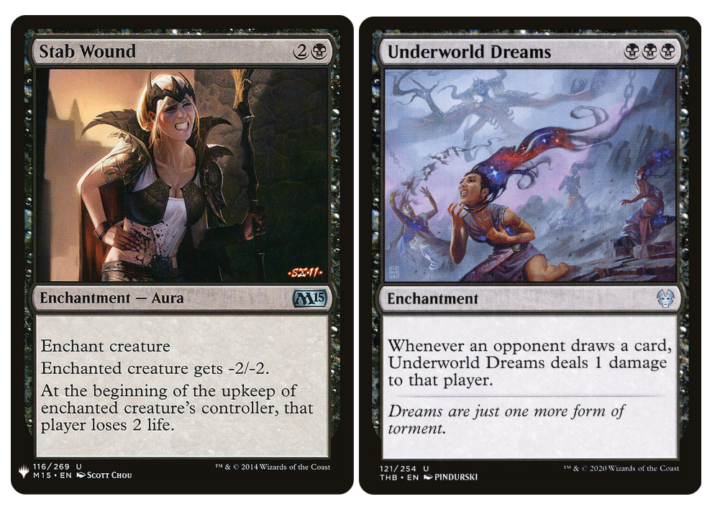
Black is the most eligible color other than blue for supporting a traditional control strategy, since its discard effects, like counterspells, can effectively answer any type of card. Compared to blue, black’s ability to bust out unfair threats at any time allows for a more explosive and flexible approach to such strategies.
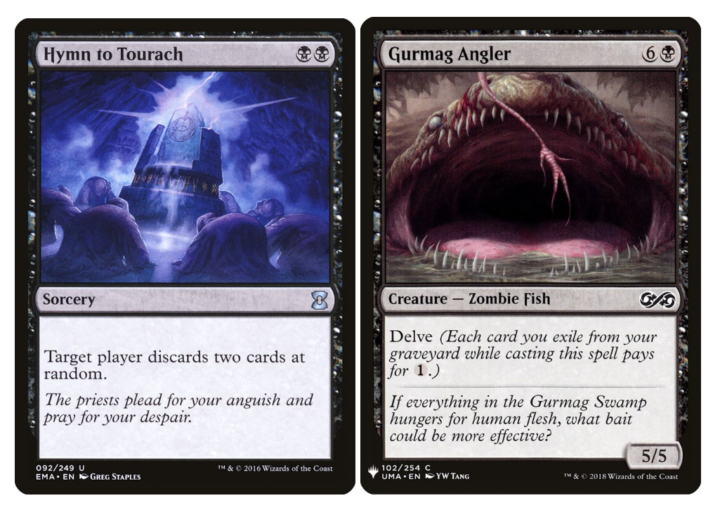
Black is potentially the greatest combo color in Magic history. The idea of “greatness, at any cost” and its efficient transmutation of resources fit this style of play to perfection. Black can use tutors to dig up the exact winning combination of cards it needs and render an opponent helpless with its hand disruption before using some explosive mana engine or ritual to cast all the spells it needs and end the game in one fell swoop. The fact that a majority of Magic’s most potent combos involve the graveyard to some degree also helps.
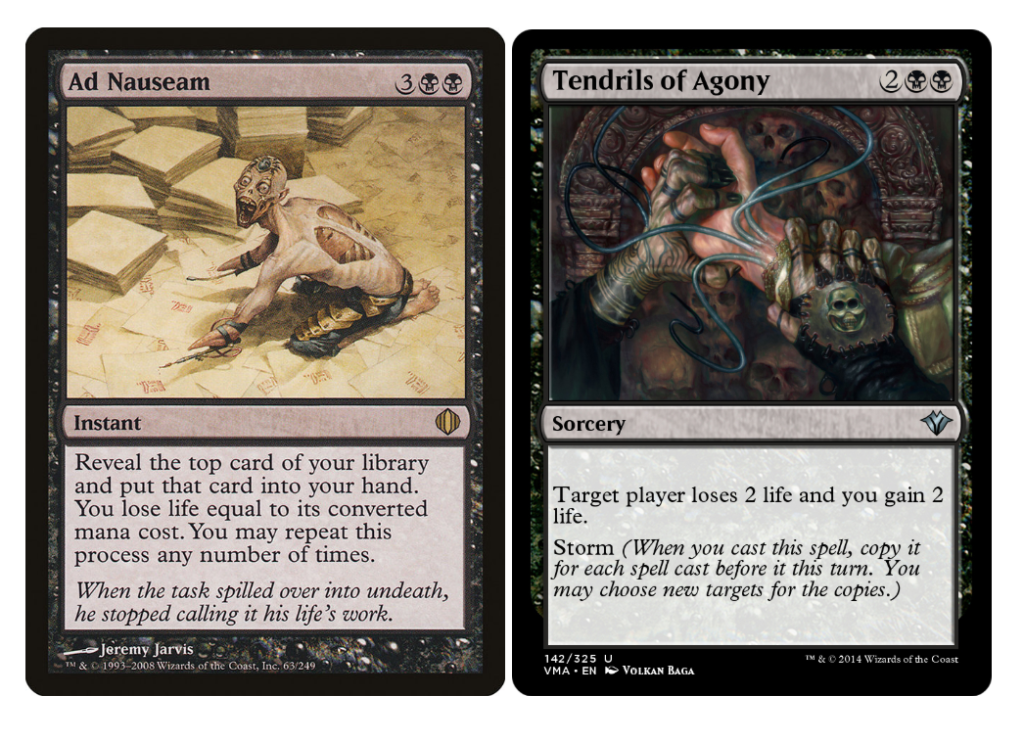
FOUND YOUR COLOR(S)? WHAT’S NEXT?
Now that you understand the themes and flavor of each color, you hopefully have some idea about the one you want to try first. How can you go about that? The answer depends on what sort of Magic you’re looking to start with.
Most times, this decision is half-made for you. If your friends who are pushing you to try Magic all meet up to play Commander, then you’ll want to make sure you build a Commander deck. If you already know you’re competitive about games and you want to test yourself with Magic, you probably want to build a deck for a tournament constructed format. The decision is important to make early, because every format has its own rules about which cards you’re allowed to play.
Whichever format you end up playing, remember to have fun and keep an open mind. If you have firm ideas about one color, I hope that you’ll soon find the motivation to explore one or two more. Multi-color decks can be tons of fun, and every 2- or 3-color combination has its own official lore and abilities. Keep testing things out and leveling up your play experience until you’re comfortable creating your own Magic decklists from scratch — then you’ll really be able to see what the game is all about.

Tom’s fate was sealed in 7th grade when his friend lent him a pile of commons to play Magic. He quickly picked up Boros and Orzhov decks in Ravnica block and has remained a staunch white magician ever since. A fan of all Constructed formats, he enjoys studying the history of the tournament meta. He specializes in midrange decks, especially Death & Taxes and Martyr Proc. One day, he swears he will win an MCQ with Evershrike. Ask him how at @AWanderingBard, or watch him stream Magic at twitch.tv/TheWanderingBard.

